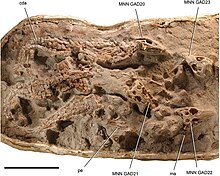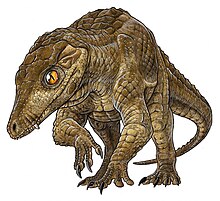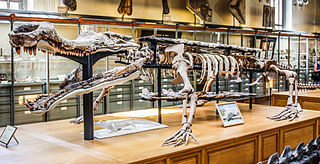
Sarcosuchus is an extinct genus of crocodyliform and distant relative of living crocodilians that lived during the Early Cretaceous, from the late Hauterivian to the late Cenomanian, 133 to 93 million years ago of what are now North Africa and South America. The genus name comes from the Greek σάρξ (sarx) meaning flesh and σοῦχος (souchus) meaning crocodile. It was one of the largest pseudosuchians, with the largest specimen of S. imperator reaching approximately 9–9.5 metres (29.5–31.2 ft) long and weighing up to 3.45–4.3 metric tons. It is known from two species; S. imperator from the early Albian Elrhaz Formation of Niger, and S. hartti from the Late Hauterivian of northeastern Brazil. Other material is known from Morocco and Tunisia and possibly Libya and Mali.

Simosuchus is an extinct genus of notosuchian crocodyliforms from the Late Cretaceous of Madagascar. It is named for its unusually short skull. Fully grown individuals were about 0.75 metres (2.5 ft) in length. The type species is Simosuchus clarki, found from the Maevarano Formation in Mahajanga Province, although one isolated multicuspid tooth of this genus was discovered in Kallamedu Formation of India.

Anatosuchus is an extinct genus of notosuchian crocodylomorph discovered in Gadoufaoua, Niger, and described by a team of palaeontologists led by the American Paul Sereno in 2003, in the Journal of Vertebrate Paleontology. Its duck-like snout coincidentally makes it resemble a crocoduck, an imagined hybrid animal with the head of a crocodile and the body of a duck.
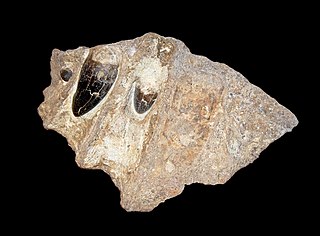
Razanandrongobe is a genus of carnivorous ziphosuchian crocodyliform from the Middle Jurassic of Madagascar. It contains the type and only species Razanandrongobe sakalavae, named in 2004 by Simone Maganuco and colleagues based on isolated bones found in 2003. The remains, which included a fragment of maxilla and teeth, originated from the Bathonian-aged Sakaraha Formation of Mahajanga, Madagascar. While they clearly belonged to a member of the Archosauria, Maganuco and colleagues refrained from assigning the genus to a specific group because the fragmentary remains resembled lineages among both the theropod dinosaurs and crocodylomorphs.

Notosuchia is a suborder of primarily Gondwanan mesoeucrocodylian crocodylomorphs that lived during the Jurassic and Cretaceous. Some phylogenies recover Sebecosuchia as a clade within Notosuchia, others as a sister group ; if Sebecosuchia is included within Notosuchia its existence is pushed into the Middle Miocene, about 11 million years ago. Fossils have been found from South America, Africa, Asia, and Europe. Notosuchia was a clade of terrestrial crocodilians that evolved a range of feeding behaviours, including herbivory (Chimaerasuchus), omnivory (Simosuchus), and terrestrial hypercarnivory (Baurusuchus). It included many members with highly derived traits unusual for crocodylomorphs, including mammal-like teeth, flexible bands of shield-like body armor similar to those of armadillos (Armadillosuchus), and possibly fleshy cheeks and pig-like snouts (Notosuchus). The suborder was first named in 1971 by Zulma Gasparini and has since undergone many phylogenetic revisions.

Peirosauridae is a Gondwanan family of mesoeucrocodylians that lived during the Cretaceous period. It was a clade of terrestrial crocodyliforms that evolved a rather dog-like skull, and were terrestrial carnivores. It was phylogenetically defined in 2004 as the most recent common ancestor of Peirosaurus and Lomasuchinae and all of its descendants. Lomasuchinae is a subfamily of peirosaurids that includes the genus Lomasuchus.

Baurusuchidae is a Gondwanan family of mesoeucrocodylians that lived during the Late Cretaceous. It is a group of terrestrial hypercarnivorous crocodilians from South America and possibly Pakistan. Baurusuchidae has been, in accordance with the PhyloCode, officially defined as the least inclusive clade containing Cynodontosuchus rothi, Pissarrachampsa sera, and Baurusuchus pachecoi. Baurusuchids have been placed in the suborder Baurusuchia, and two subfamilies have been proposed: Baurusuchinae and Pissarrachampsinae.

Sphagesaurus is an extinct genus of sphagesaurid notosuchian crocodylomorph from the Late Cretaceous of southwest São Paulo, southern Brazil.

Armadillosuchus is an extinct genus of sphagesaurid crocodylomorph. It was described in February 2009 from the late Campanian to early Maastrichtian Adamantina Formation of the Bauru Basin in Brazil, dating to approximately 70 Ma. Armadillosuchus was among the larger and more robust sphagesaurids, with a total length of approximately 2 metres (6.6 ft).
Stolokrosuchus is an extinct genus of crocodyliforms that lived during the Early Cretaceous. Its fossils, including a skull with a long thin snout and bony knobs on the prefrontal, have been found in Niger. Stolokrosuchus was described in 2000 by Hans Larsson and Boubacar Gado. The type species is S. lapparenti. They initially described it as related to Peirosauridae, if not a member of that family. One study has shown it to be related to Elosuchus. However, more recent works usually find Stolokrosuchus to be one of the basalmost neosuchian, only distantly related to the elosuchid or pholidosaurid, Elosuchus. It was a semiaquatic crocodylomorph.
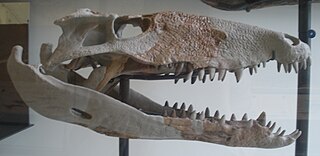
Metasuchia is a major clade within the superorder Crocodylomorpha. It is split into two main groups, Notosuchia and Neosuchia. Notosuchia is an extinct group that contains primarily small-bodied Cretaceous taxa with heterodont dentition. Neosuchia includes the extant crocodylians and basal taxa, such as peirosaurids and pholidosaurids. It is phylogenetically defined by Sereno et al. (2001) as a clade containing Notosuchus terrestris, Crocodylus niloticus, and all descendants of their common ancestor.

Sebecus is an extinct genus of sebecid crocodylomorph from Eocene of South America. Like other sebecosuchians, it was entirely terrestrial and carnivorous. The genus is currently represented by two species, the type S. icaeorhinus and S. ayrampu. Several other species have been referred to Sebecus, but were later reclassified as their own genera.

Comahuesuchidae is a family of notosuchian crocodyliforms. Constructed in 1991, it includes the genera Comahuesuchus and Anatosuchus. Among the characteristics that are unique to this family is an external naris that is inset into the tip of the snout. There is also a diastema, or gap between the teeth, at the tip of the upper and lower jaws. Both Anatosuchus and Comahuesuchus have maxillary tooth rows in the upper jaw that extend out and over the dentary tooth rows of the lower jaw.
Sebecosuchia is an extinct group of mesoeucrocodylian crocodyliforms that includes the families Sebecidae and Baurusuchidae. The group was long thought to have first appeared in the Late Cretaceous with the baurusuchids and become extinct in the Miocene with the last sebecids, but Razanandrongobe pushes the origin of Sebecosuchia to the Middle Jurassic. Fossils have been found primarily from South America but have also been found in Europe, North Africa, Madagascar, and the Indian subcontinent.

Ziphosuchia is a clade of mesoeucrocodylian crocodyliforms that includes notosuchians and sebecosuchians.

Caipirasuchus is an extinct genus of sphagesaurid notosuchians known from the Late Cretaceous of northern São Paulo State, southeastern Brazil. The type species, C. paulistanus, was named in 2011. A second species, C. montealtensis, was referred to Caipirasuchus in 2013 after having been named in 2008 as a species of Sphagesaurus. A third species, C. stenognathus, was described in 2014. A fourth species, C. mineirus, was described in 2018. A fifth species, C. attenboroughi, was named in 2021 in honour of David Attenborough.
Labidiosuchus is an extinct genus of notosuchian crocodyliforms from Minas Gerais State, southeastern Brazil. Labidiosuchus had a very bizarre dentition and its lower jaw had a Y-shaped outline.

Uruguaysuchidae is a family of notosuchian crocodyliforms that lived in South America and Africa during the Cretaceous period. It includes the genera Araripesuchus and Uruguaysuchus. Below is a cladogram from Soto et al. (2011):

Antaeusuchus taouzensis is a species of peirosaurid notosuchian from the Late Cretaceous Kem Kem Group of Morocco. It was described in 2021, and it is the only species in the genus Antaeusuchus. It is the fourth notosuchian described from the region and the second Kem Kem peirosaurid after Hamadasuchus. A 2023 study proposes that Antaeusuchus may not be distinct enough to warrant its own genus and that it instead represents another species of Hamadasuchus.
Barrosasuchus is a genus of peirosaurid notosuchian from the Santonian of Argentina and part of the extensive peirosaurid record of Late Cretaceous Patagonia. It contains one species, Barrosasuchus neuquenianus. B. neuquenianus is known from an almost complete skull and the majority of the articulated postcranial skeleton, making it the best preserved Patagonian peirosaurid.

